In 2016, 43% of Americans spent at least some time working remotely. Employees are pushing companies to break long-established routines, allowing workers flexible scheduling and home-based opportunities.
Studies have found that those who work from home are more productive and put in more hours. Due to such success, there’s been a boost in the number of businesses offering remote work.
Today’s workers have more freedom than ever. With remote work opportunities, they can move anywhere in the world. How will the transition to at-home employment affect the real estate market?
A Shift to Suburban Areas
If you want to find success in your career, you have to head to a metropolis like New York City, Los Angeles or San Francisco. At least, that’s how it used to be. Today, remote work options make it possible for people to relocate to more affordable areas. Instead of barely scraping by, people have the chance to flourish.
To see how this works in action, take the story of one remote worker in a recent Wall Street Journal article. She worked as a health care information technology consultant in Los Angeles living paycheck to paycheck. When her boss provided the option to work from home, she packed her family up and moved to Boise, Idaho. With the cost of living being 35% lower, her quality of life greatly improved.
Tech-Studded Apartments
With remote work on the rise, it’s more important than ever to stay connected. Smart homes and apartments are becoming increasingly popular, with interconnected devices, appliances and services. According to one report, 86% of millennials are willing to pay more in rent for an apartment with automation.
Today’s apartment complexes future-proof their investments with interconnected infrastructures. Using two networks — a Wi-Fi network and Bluetooth mesh — tenants can connect to the internet and add hundreds of cellular getaways. Popular devices for home-based workers include smart coffee makers, thermostats and lighting.
The American Dream
The American Dream — owning a single-family home with a yard and white picket fence — is very much alive. According to one survey on Apartment List, 80% of millennial renters want to purchase a home. They crave space and greenery, not tiny apartments and concrete. Unfortunately, 72% of millennial renters can’t afford to buy, especially in a city like New York or Los Angeles.
With remote work increasing in popularity, more people are jumping at the opportunity to flock from the cities toward affordable real estate. There’s a huge demand for suburban property, with home-based employees lining up to find their next dream abode. Homeowners and businesses alike are being forced into second-tier cities, such as Dallas and Pittsburgh, to seek affordability.
Much-Needed Amenities
Home-based employees need a different variety of amenities compared to someone who commutes to work. The importance of in-home offices has skyrocketed. Working from the couch or kitchen table won’t cut it — homes with offices are especially attractive to buyers.
Another sought-after home amenity is daylighting, the use of natural light to illuminate the home’s interior. Designers and researchers have touted daylighting for its health benefits, with reports that it increases occupant productivity and comfort. Plus, the use of daylighting can help eco-conscious homeowners conserve electricity and save money. For remote workers who spend so much time at home, amenities that promote wellness are crucial.
A New Type of Workspace
Many employees can work from home but don’t. Instead, they rent a spot in a co-working space, an office-like community where they can take advantage of equipment and collaborate with peers. In 2018, more than 2,000 new co-working spaces opened worldwide, 1,000 in the U.S. alone. Experts predict that another 1,688 will crop up this year.
The demand for co-working spaces is growing. For remote workers, being inside the house alone all day can be taxing. More and more people are giving the new setup a try. A co-working space offers a mental break that will allow you to work in an office-like setting with more freedom and flexibility.
Luxury Common Areas
Remote work gives people the flexibility to seek out a living situation that best meets their needs. While many cannot afford homeownership, some look to luxury apartment accommodations that are just as lavish. Developers have started incorporating creative amenities in attempts to one-up the competition and draw in more renters.
Home-based employees have more options than ever when it comes to where to live, and the luxury apartment building boom has yet to slow down. Through 2020, experts anticipate the construction of over 1.3 million new units. Many of these may feature creative common areas and luxury finishes that speak to the needs of workers who spend many of their days at home.
Shared Living Spaces
Not all remote workers want to flee the booming metropolises. Those who stay are willing to cut living expenses with dormitory-style living. In places like New York City and San Francisco, young professionals often choose to live in spaces with a shared kitchen and living room, which allows them to pay a much lower daily rent.
Most find that they can live comfortably without wasting a lot of space and money. Each person still has a private bedroom where they can retreat for privacy. As a bonus, the complex cleans the common areas daily. This type of housing option is expected to grow in popularity in cities around the world, especially those experiencing real estate scarcity.
Remote Work and Its Effect on Real Estate
The rise in remote work opportunities has had a significant impact on the real estate market. Employees are fleeing big, expensive cities, and the demand for suburban properties is growing.
For many, homeownership is the dream. People crave privacy, something that’s hard to find when renting. Remote work provides the opportunity to live in an affordable area. Remote workers who still prefer to rent can take advantage of much more flexibility with where they can live.
Developers are attempting to compensate for this uptick in competition by incorporating the newest tech and luxury amenities. Urbanites who don’t want to flee the city can also enjoy lower rent with dormitory-style living.
The point is that as a home-based worker, you have the freedom to live anywhere in the world. The real estate market is shifting to meet your demands, from apartment living to homeownership — take your pick!
Find a Home-Based Business to Start-Up >>> Hundreds of Business Listings.

















































